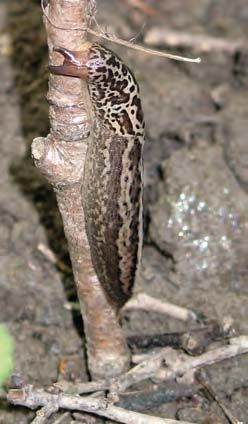|
Knitsley ravine, County Durham is accessed via a spectacular railway viaduct which now carries a long-distance footpath / cycle track. The site is very varied, consisting of sandstone / Coal Measures valley side woodland with a rich ground flora, sandstone screes probably formed when rock was removed for construction of the facings for the viaduct, and an alder carr which is considered to be the finest in the county. Twelve land molluscs were found in the sandstone areas, including a shell of Zenobiella subrufescens. In the alder carr the species count increased to 16 live animals including Columella edentula, Acanthinula aculeata, Euconulus alderi, E. fulvus and a fine specimen of Limax maximus crawling up a twig. When the Society visited the other wellknown alder carr in County Durham, at South Burn, Waldridge Fell, 23 species were recorded in 1998. While the South Burn used to be black with coal dust from the old pit workings, the alder carr on either side escaped disturbance from this source and in many years the site is too boggy to be entered even wearing wellingtons. However the Knitsley site may have seen massive disturbance when the railway viaduct was built and this may had a long-term effect on the number of mollusc species present. A steep wooded valley by Egglestone Abbey Bridge on the River Tees, owned by Durham County Council was among the sites visited. This is a mixture of sycamore, oak, ash and hornbeam on limestone, with plenty of fallen timber and little evidence of disturbance away from the riverside path. Efforts to find molluscs were hampered by fairly continuous rain and deep gloom, such that this was the only site covered on that day. Analysis of a leaf litter sample by sieving helped to boost the results to 20 species by finding the smaller ones such as Acanthinula aculeata and Punctum pygmaeum. The most interesting record was Limax cinereoniger, found by pulling a hank of moss from the ground. The startled slug recoiled, behaviour more like that expected of a mammal. This is a species of particular interest to the County Council’s Conservation Officer and which had not been previously recorded in the area. One site in the County well worth a visit by anyone interested in natural history is Low Barns Nature Reserve, Durham Wildlife Trust (DWT), this area of alder woodlands, gravel pits, riverside and remnants of Coal Measure woodlands boasts an extensive new walkway across a newly created wildlife lake, giving an excellent views of aquatic life, particularly for children. If colonised effectively from the other wet areas on the site, this may develop into a quality habitat with time. A seasonally flooded alder wood with lying dead timber yielded twelve species, a small pond dug for educational purposes had six common species but the adjacent stream had Ancylus fluviatilis, a species probably under-recorded from the County. Heselden Dene is one of the smaller of the County Durham wooded coastal denes cutting through the Magnesian limestone belt. This is also a Durham Wildlife Trust reserve but suffers from considerable vegetation disturbance as it is close to a sizeable ex-colliery village. Seventeen species were found including Columella edentula, Lauria cylindracea and Ena obscura but the nearby larger Hawthorn Dene (also a DWT nature reserve, visited by the Society in 1998) gave 41 species but has only a small agricultural village nearby and an intact ground flora. Further thoughts on the effects of disturbance prompted a visit to the urban local nature reserve of Hetton Bogs near Houghtonle- Spring. This area has a long history of disturbance, starting with agricultural mills followed by industrial mills at several points along the streams running through the site, followed by colliery activity. The area is within walking distance of a sizeable population. Only nine common species were found, despite the development of apparently promising wetland vegetation. Proximity to human population does not always rule out interesting finds. Among the twenty species found in a relatively short time in the sycamore woods on steep sandstone slopes below the castle and above the River Coquet at the small town of Warkworth, Northumberland was Spermodea lamellata. This was also found at Raintonpark Woods, near Leamside, Durham at the 1998 field meeting. |
Fig 1 Limax maximus crawling in the open in the alder carr at Knitsley Ravine. |
The June 2005 Durham field meeting and observations from other sites in NE England
Issue
11
Page
24

